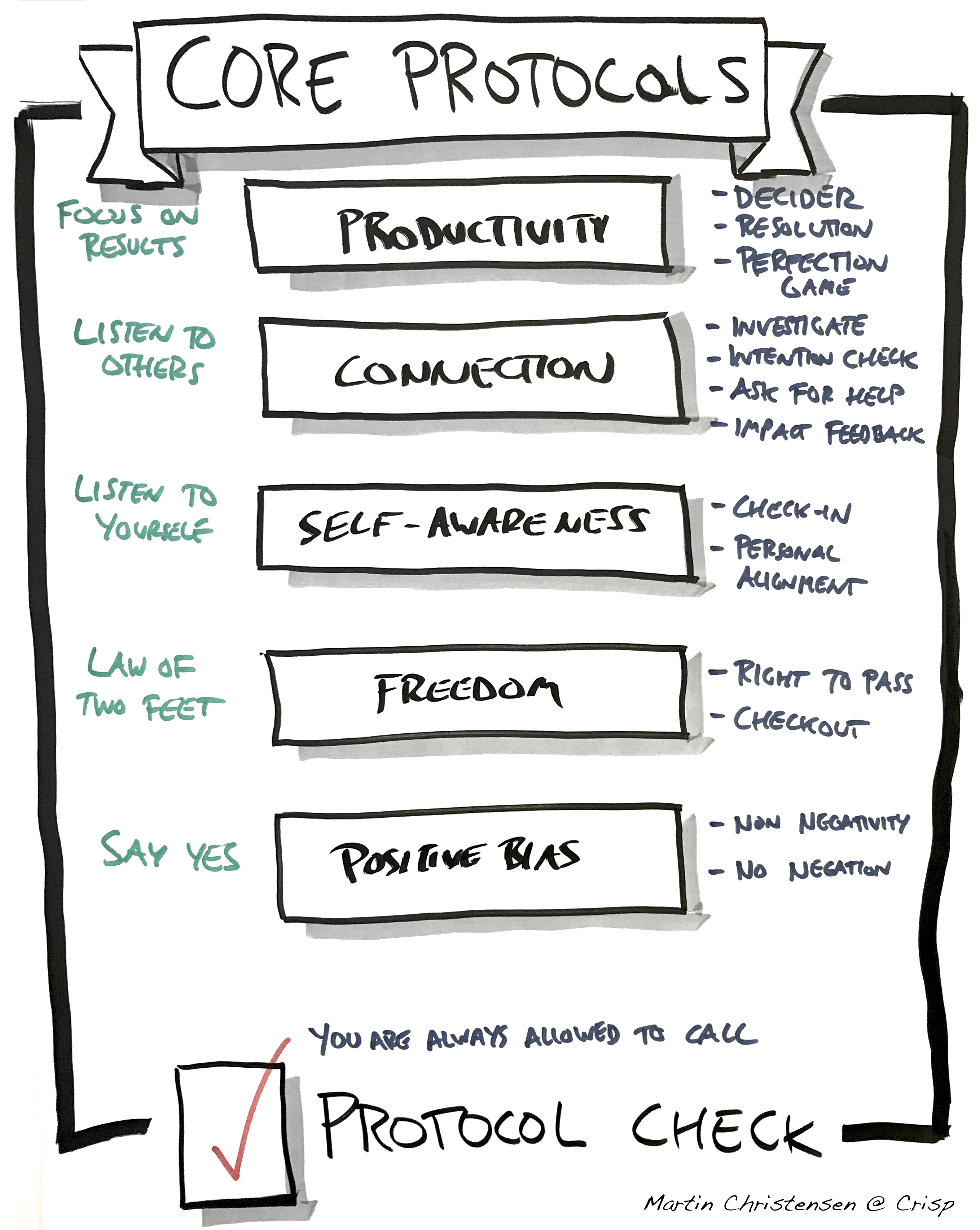– Having rules for communication is stupid!
– What was your intention with calling the rules stupid?
– Well, I’m sorry, I didn’t mean anything negative towards you, of course. I just don’t find such rules necessary at all. We have been communicating with each other since we were small.
– Okay, I understand what you are saying. But, hear me out…

Are you in the startup stage with your new team and want a great foundation for communication? Have you been struggling with person-to-person communication and need a solution? Keep calm and let me introduce you to my interpretation of the Core Protocols by Jim and Michelle McCarthy, arranged in a practical culture-as-a-protocol-stack by Richard Kasperowski (and previously written about from a meeting perspective by Peter Antman in this blog).
The Core Protocols is a set of communication protocols focusing on human-to-human communication. (A protocol in this case is a set of rules for exchange of information between parties.) I have found them to be a bit too formal so what I describe below is my interpretation that tries to explain more about the value of the protocol and general acting than specific sentences to be used. Those specifics, if needed, can be found in the links above.
The Core Protocols can act as a foundation for a healthy team culture, hence the name Core. It can be used as an agreement for a way of behaving and working together – between people in a team, between teams and in an organisation as a whole. I have found it very benifical to agree upon using Core Protocols as a base when forming a new team. When introducing it to an already existing team, the usual response has been “oh, that’s common sense, we already do that, but not so (stupidly) formalised”. In either situation, I have introduced the Core Protocols with a discussion-based lecture and then tried it out in all communications within the team for about a month, to make it stick, with continuous discussions and adaptations of the protocols during that time.
Culture as a protocol stack
 The technical definition of a protocol stack (such as the TCP/IP network stack) is that the bottom layer can exist on its own, but to create the intended experience, the layers above will not work without the ones below. For instance, if you want to use the protocol Intention check from the Connection-layer of the Core Protocols, it is required that you (and your conversation partner) follow the protocols in the Positive bias, Freedom and Self-awareness layers, to get the planned result.
The technical definition of a protocol stack (such as the TCP/IP network stack) is that the bottom layer can exist on its own, but to create the intended experience, the layers above will not work without the ones below. For instance, if you want to use the protocol Intention check from the Connection-layer of the Core Protocols, it is required that you (and your conversation partner) follow the protocols in the Positive bias, Freedom and Self-awareness layers, to get the planned result.
Protocol: Protocol check
You are also always allowed to call Protocol check, which is a general protocol for the whole stack. For instance, say “Protocol check. Can someone explain the Right to pass protocol to me?”. Protocol check can also be called if you think that an interaction does not work as it should. Everyone involved in the exchange should then think about how the interaction could improve and act correspondingly.
The layers and the protocols
 A group with a positive attitude towards each other is a more productive group. (Added by Richard Kasperowski.) A group with a positive attitude towards each other is a more productive group. (Added by Richard Kasperowski.) |
Principle: Say Yes – always listen and answer with a positive mindset, always interpret what is being said in the most positive way.
Protocol: No negation, Non negativity (added by Richard Kasperowski)
Strengthen the involvement, dedication and courage of each other. Provide space and invite others to participate. Try to understand each others’ intentions and be open and positive to all arguments, even arguments you have previously rejected. Use positive words to enhance opportunities. Do not judge or punish others who speak.
 If you have the possibility to leave, your motivation for staying will be higher since you are there of your own free will. If you have the possibility to leave, your motivation for staying will be higher since you are there of your own free will. |
Principle: Law of two feet – If you find yourself in any situation where you are neither learning nor contributing, use your two feet, go someplace else where you can feel more productive.
Protocol: Checkout
When you are present, you should be engaged. If you can’t be engaged, it is better to check out of the situation so you don’t negatively influence the energy of the others. For instance, if your mind wanders due to some external reason or if you get so angry that you can’t think straight, do a checkout. The other part should always accept a checkout. When you do a checkout, you should say when you will return and, if you want, the reason for the checkout.
Protocol: Right to pass
If you feel uneasy, you have the right to pass participating in an activity, such as answering a question or attending a meeting. You don’t have to explain yourself, but use this protocol without explanation sparingly, since it is easy to confuse it with general animosity.
 When you understand yourself, it is easier to align with others. When you understand yourself, it is easier to align with others. |
Principle: Listen to yourself – Be aware of your own current state and motivation.
Protocol: Check-in
If you understand your current state of mind, you will be able to steer around difficult situations. When you do a check-in, you explain your state of mind to yourself and, if you want to, to others to ease understanding of each others’ behaviors. For instance, when you arrive in the morning, you can say “Hey guys. Today I’m very tired and probably easily annoyed. I apologize in advance for that.” This will help both you and the others with choosing the right words in your conversations during the day.
Protocol: Personal alignment
Focus your mind and yourself by thinking about why you are present today. Question yourself so that you know that you’re focusing on the right things. Do what is needed to reach a personal alignment that will support the team, for instance do a checkout if you don’t actually contribute.
Principle: Listen to others – Understand what other people actually say.
Protocol: Investigate
Ask open and neutral questions to really understand a problem, behavior or situation. Try to be the neutral interviewer. Ask “can you explain what you mean by that?” or say “please explain more, I want to understand” in a positive/neutral tone.
Protocol: Ask for help
Use each others’ knowledge in the most efficient and effective way possible. When you are the slightest uncertain, always dare to ask for help. The person who gets asked should say yes and help you or try to find someone who can.
Protocol: Intention check
If something is said which you suspect won’t lead to a positive outcome or that you felt could be accusing, use this protocol to ask for a clarification. Chances are that what was said was just clumsily formulated and no harm was intended. Ask “what was your intention with saying that?”. Ask in a positive tone.
Protocol: Impact feedback (added by me, created by The Center for Creative Leadership)
Give feedback (positive and negative, without being accusing) in the best way. If you explain the behavior (and situation) and how you experienced it, it will be easier for the receiver to figure out what could be done differently next time. Give the feedback like this: “When you said/did X, I felt Y.” Do not give suggestions for improvements.
– Hey, that protocol was unusally formal?
– Yes, that is because giving feedback is always a delicate situation. Getting it even slightly wrong can have dire consequences.
 When the other layers are working well, everyone’s motivated and communicating in the most efficient way, then you need tools to get efficiently productive. When the other layers are working well, everyone’s motivated and communicating in the most efficient way, then you need tools to get efficiently productive. |
Principle: Focus on results – Get to the point faster, time costs.
Protocol: Decider
Come to a decision quickly. First pose the decision as a a yes or no-question, then lift your fist and say 1-2-3. On 3, everyone votes with a thumbs up – I stand behind the decision, thumbs down – I want to discuss this further, and thumbs to the side – I stand aside in this decision. When everyone has thumbs up or thumbs to the side, you have a decision. The best way to do this is not to discuss first, but to try the decision. Some decisions are easy, you will get it immediately and use the time to discuss tougher decisions.
Protocol: Resolution
To get more people’s views on board and shorten the discussion time when taking a decision, you could ask the people doing thumbs down (see Decider) “what would make your thumb go up?”. The person then answers and you could change the decision question to incorporate the feedback and try a Decider again.
Protocol: Perfection game
To get constructive feedback, at the end of an activity ask for feedback in the form of “I give this activity a 3 out of 5. For it to be a 5, we would need to do X and Y next time”. This keeps the feedback rounds short and to the point.
– That was a lot to take in. How can I possibly remember all of this?
– Easy. Just call Protocol Check, Ask For Help or print this poster and put it on the wall next to your team!





Great summary Martin! Making “rules” explicit for communication, interaction, collaboration within a team is powerful for developing the dynamic within a team – getting to stability from the early phases of team development and for the team to stay there when onboarding new members! I am looking forward to send out your summary to new teams for inspiration before such exercises, and observe the effects!
Thanks Sandra! This really helps to push teams a little bit faster through their stages of group development.
Excellent work Martin! I started thinking about how I can use this and can’t decide how to make the protocol visible outside the core team. In almost all of our important meetings (in current setup) we have one or more stakeholders from outside “delivery team” in the room.
Maybe the protocol could be a part of the meeting (contact) itself or the protocol could be communicated to the stakeholders. But I guess we also need buy-in from all participants to make the protocol valid?
Thank you Björn.
The thing is that you can come a long way by only having the team thinking in the Core protocols way, and you don’t have to shout “intention check” to your stakeholders but actually know that you can and should ask a clarifying question. So, buy-in is not superimportant in the first stage.
Later, you can introduce it layer by layer… 🙂
Interesting post, thanks for sharing!